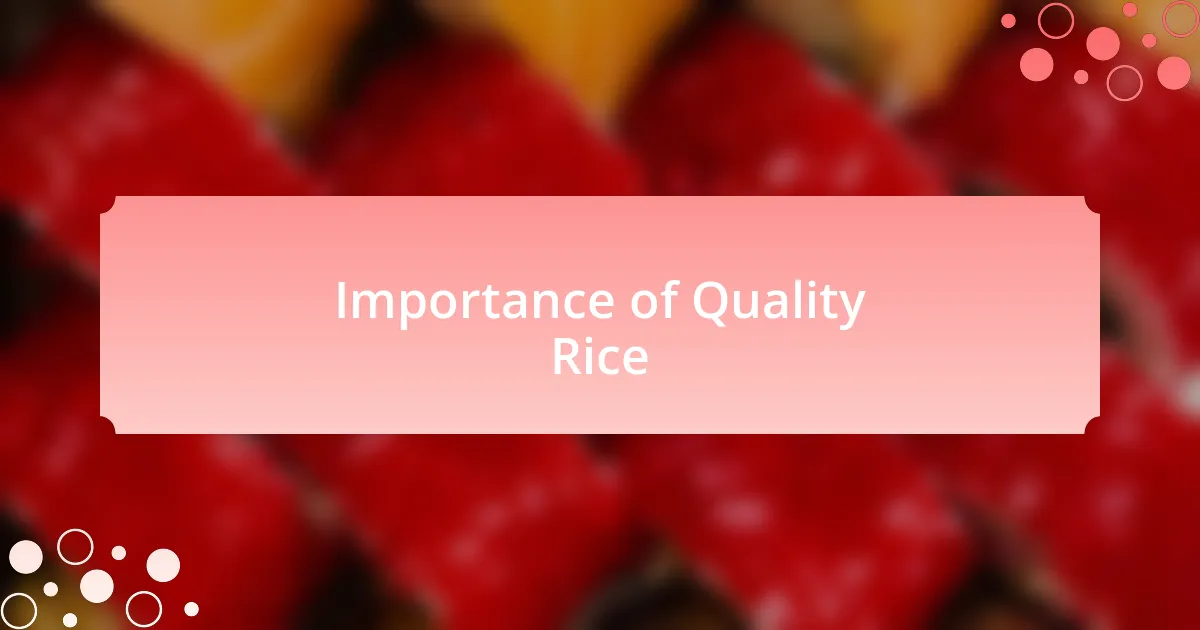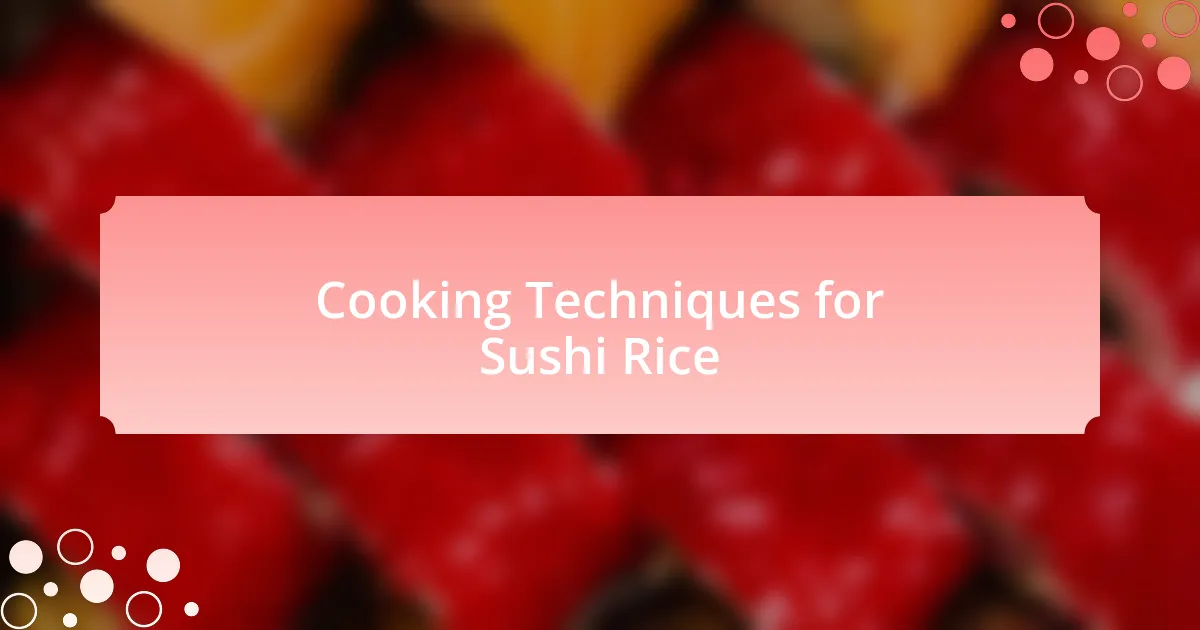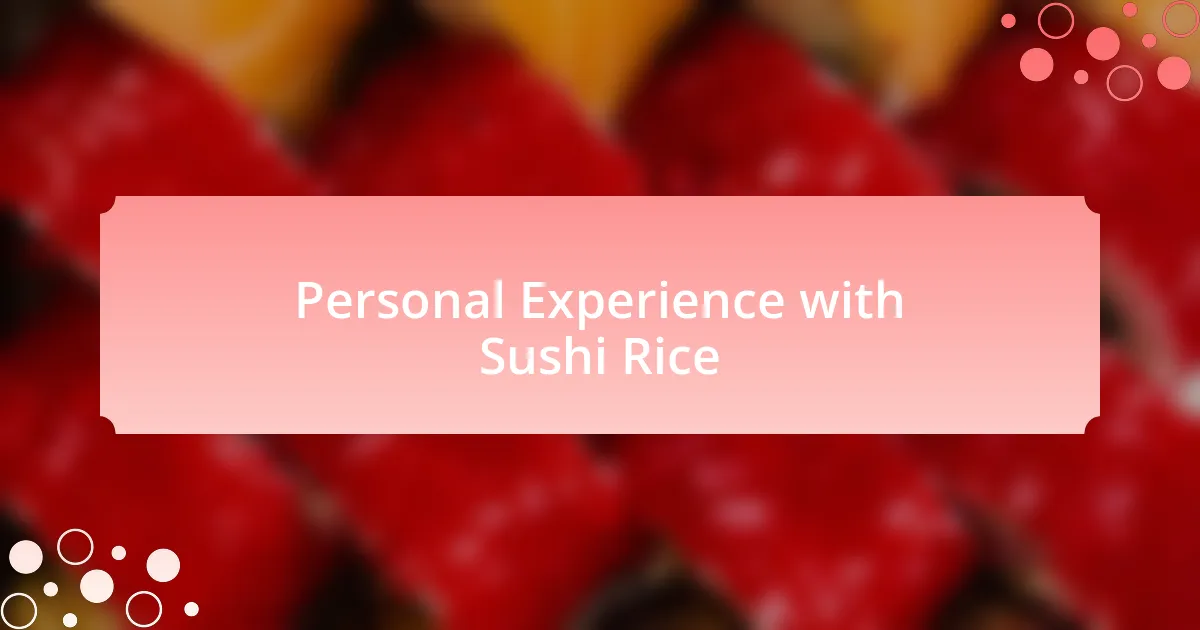Key takeaways:
- Choosing the right type of sushi rice, specifically short or medium-grain, is essential for optimal texture and flavor.
- Quality sushi rice enhances both the taste of the fish and the visual appeal of the sushi.
- Proper cooking techniques, including soaking the rice and using the correct water-to-rice ratio, are crucial for achieving the perfect sushi texture.
- Personal experience emphasizes the importance of investing in high-quality and authentic Japanese rice for a superior sushi-making experience.

Understanding Sushi Rice Types
When it comes to sushi rice, not all grains are created equal. I’ve often found that the texture can make or break the sushi experience; a good sushi rice should be sticky yet fluffy, allowing it to hold its shape without becoming gummy. Have you ever taken a bite of sushi where the rice just falls apart? That’s the result of using the wrong type of rice.
Typically, the best choices are Japanese short-grain or medium-grain rice, specially crafted to create that sought-after stickiness. I remember my first attempt at making sushi; I mistakenly used long-grain rice, expecting it to work out. The sushi rolled away from me – literally. It became clear that using the right rice is essential for both rolling and eating sushi.
There are different varieties within the short-grain category, but the most popular is often called ‘sushi rice’ or ‘shari.’ Each type has unique qualities that can influence the final flavor and texture of your sushi. I have found that experimenting with different types not only deepens my understanding of sushi making but also elevates the overall experience—each bite tells a story, and the rice is like the canvas for the flavors to shine. Have you explored different brands or types? It can truly uncover a whole new world of sushi enjoyment.

Importance of Quality Rice
Quality sushi rice is fundamental to creating an authentic sushi experience. I’ve learned that using premium rice not only enhances the flavors of the fish but also contributes to the visual appeal of the rolls. Have you ever noticed how a well-formed sushi piece seems to invite you in? That allure often comes from the quality of the rice.
I once participated in a sushi-making workshop where the instructor emphasized that the right rice can elevate even the simplest ingredients. I still remember the first bite of a perfectly crafted nigiri: the rice felt like it was hugging the fresh fish, creating a mouthwatering harmony. It struck me that this delicate balance can only be achieved with the finest quality rice, and everything else falls flat without it.
Moreover, the way rice interacts with vinegar and sugar during preparation greatly influences the overall sushi experience. I’ve experimented with different brands, and there’s a noticeable difference in both texture and taste. If you think about it, why settle for anything less than the best when it can transform your sushi from average to outstanding?

Tips for Selecting Sushi Rice
Selecting the right sushi rice can be a game-changer in your sushi-making journey. I remember my first attempt at making sushi; I grabbed a generic brand without much thought. The rice ended up mushy and lacked that signature stickiness, making it practically impossible to shape into rolls. It’s essential to choose short-grain rice, specifically labeled as sushi rice or japonica, to achieve that perfect texture.
When I discovered the significance of rice quality, everything changed. One evening, I decided to invest in a premium sushi rice from a local Asian market. Not only did it look more polished, but the flavor and consistency were leaps and bounds ahead of what I had used before. It felt like I had unlocked a secret — the rice can make or break the dish, transforming each bite into a delightful experience.
Additionally, pay attention to the rice’s moisture content; the ideal sushi rice should be slightly sticky but not gluey. I often rinse the rice until the water runs clear to remove excess starch, which has dramatically improved the texture. Have you ever wondered why some sushi restaurants have that perfect bite? It’s often the meticulous preparation of their rice that sets them apart.

Cooking Techniques for Sushi Rice
Cooking sushi rice is more than just boiling a pot; it’s an art that requires just the right touch. I distinctly remember my first successful attempt when I carefully measured my water and rice, only to find out that my gut feeling was right: a 1:1 ratio works wonders. Isn’t it gratifying when simple adjustments lead to delicious outcomes?
When it comes to cooking, I’d highly recommend using a rice cooker if you have one. I used to think just any pot would do until I experienced how a rice cooker takes the guesswork out of the equation. It not only steams the rice to perfection but also keeps it warm for longer, which is essential when you’re preparing other ingredients for your sushi.
After cooking, let the rice rest for about 10 minutes, covered, to allow it to steam further. I learned the importance of this technique the hard way; my impatience led to a clump of rice that wouldn’t hold together as I rolled. Waiting can feel tedious, but trust me—it’s worth it for achieving that ideal sushi texture.

Personal Experience with Sushi Rice
Choosing the right sushi rice has become a deeply personal journey for me. I remember the first time I visited a renowned sushi restaurant; the rice was so perfectly sticky yet fluffy that I couldn’t help but ask the chef about it. His simple reply about using short-grain rice was a revelation that made me realize how crucial the type of rice is to the overall experience.
On another occasion, I thought I could skimp on quality and purchased a generic brand, believing that all sushi rice was the same. What a mistake that was! The texture was off, and it didn’t hold together at all—nothing like what I’d tasted before. I learned the hard way that investing in high-quality sushi rice pays off. Is there anything more disappointing than bad sushi at home?
Now, I always make it a point to seek out authentic Japanese brands. The excitement of preparing my sushi is amplified when I know the rice is top-notch. The moment I take that first bite, it’s like a comforting hug of nostalgia, bringing back memories of those incredible restaurant experiences. Don’t you just love it when food connects you to moments in your life?

Final Thoughts on Choosing Rice
When choosing sushi rice, one crucial aspect is to consider its texture. I recall a sushi night where I experimented with different brands. Each time, I enjoyed a different result—a super sticky blend that felt like a warm embrace versus a grainy version that barely stayed together. It made me appreciate how the right texture transforms sushi from ordinary to extraordinary.
Another factor I’ve learned is the importance of soaking rice before cooking. The first time I skipped this step, I ended up with undercooked grains that just fell apart. Now, I soak the rice, knowing it will absorb the right amount of water and cook to that perfect, chewy consistency I crave. Isn’t it fascinating how a little extra preparation can lead to such a difference in the final product?
In conclusion, my sushi rice journey has taught me to appreciate the subtleties—like choosing the right grain or mastering the soaking process. Through trial and error, I’ve discovered that each decision, no matter how small, has the potential to elevate the entire experience. Have you ever thought about how much care goes into creating great sushi at home?